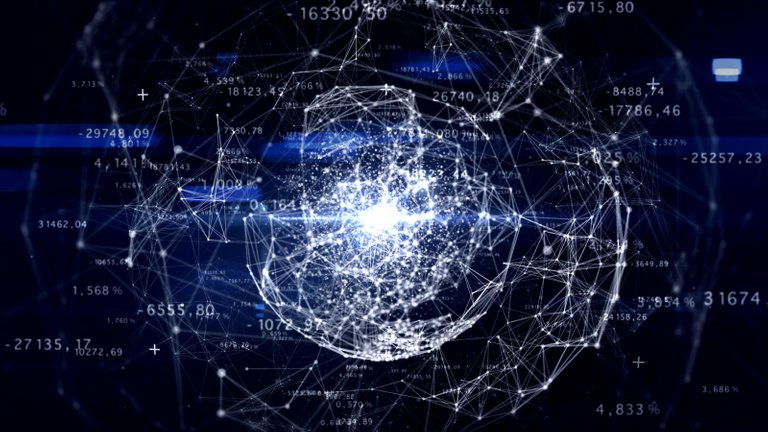
Out of all revolutionary ideas driving the advancement of cryptocurrency and blockchain technology, there is no greater ambitious vision than that of the IOTA project.
Many visions of the future portray a picture of a world where everything is inter-connected; a world where data storage and automation is a part of every humans daily life.
This future-istic concept is known as the Internet of Things, and while steady progress has been made to advance its adoption and use-ability, it still faces many challenges.
Let us go over the vision of the IoT as whole, the challenges it faces moving forward, and the role IOTA will play in its future.
The IoT Vision:
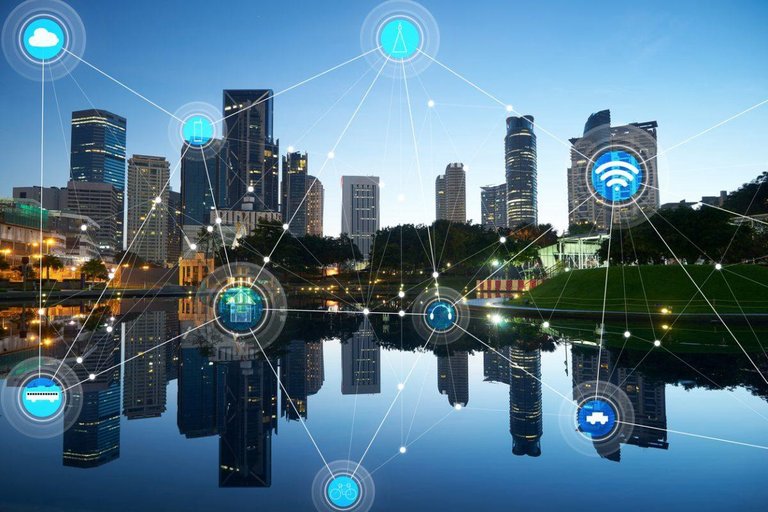
While one can argue that the Internet of Things is partly already here via RFID and machine-to-machine services, what most don’t understand is that these deployments are, at best, properties of the Intranet of Things.
The Intranet of Things, depending on your viewpoint, is either a sole element of the all encompassing Internet of Things, or an alternative model; in either case, it utilizes similar technical systems but is limited due to to its lack of interopability and support of fully connected devices.
A true Internet of Things will require IP in the even the tiniest devices: allowing them to monitor and control real world objects. Additionally, with true inter-connectivity, services and data from these devices will somehow be more openly available for applications to make use of. This utilization of standard IP and Web technologies will ensure that device costs are driven down and that application development and use will be significantly simplified.
As shown by the timeline below, the end-goal of the IoT is to have plug-n-play smart objects that can be deployed in any environment with an interopable interconnected backbone that allows them to blend and interact with other smart objects around them without the need for human interference.
The diagram below displays a road-map of the key research developments of the IoT, including the technological drivers and key application outcomes for the next 10 years.
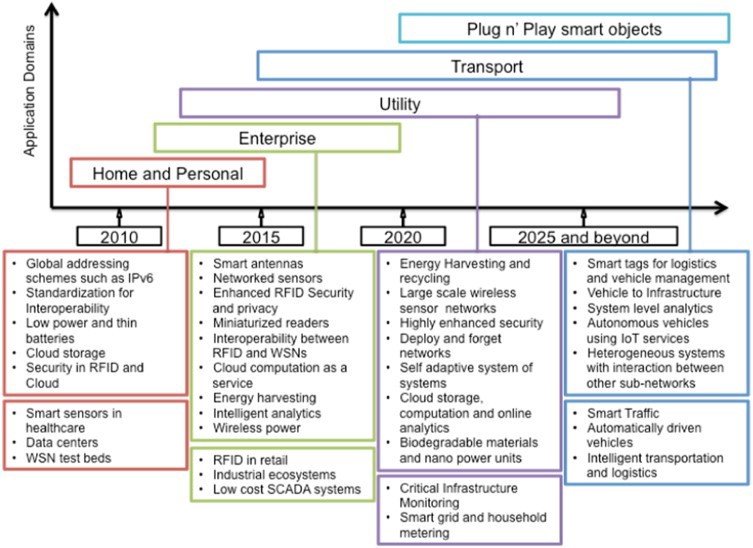
(Source: Elsevier B.V. A., 2013, Internet of Things (IoT): A vision, architectural elements, and future directions)
Challenges of the IoT:
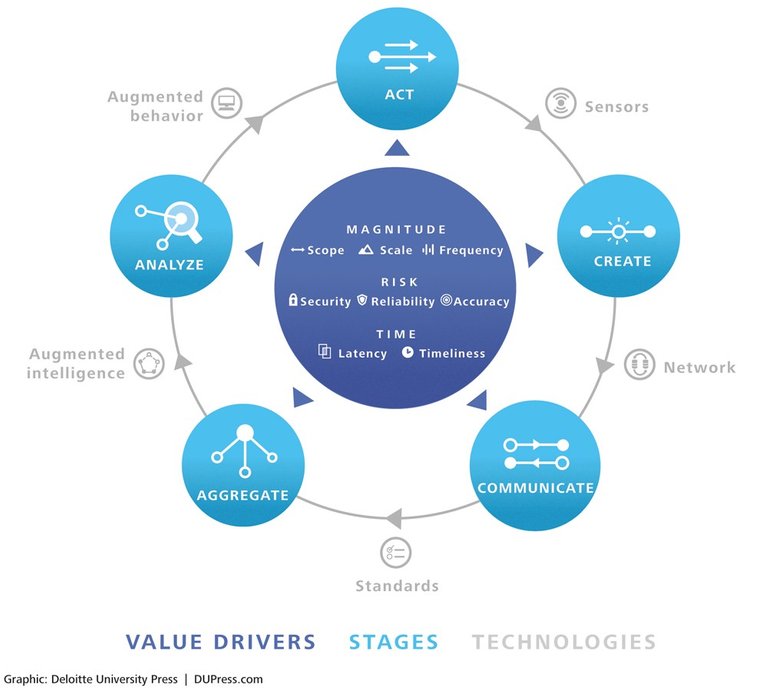
The exponentially increasing number of connected devices, along with the expected rise in real-time IoT applications will substantially stress the performance of today’s networks.
In order to provide high-quality experiences among IoT users, a massive reduction of end-to-end latency among machine-to-machine transactions is imperative.
In addition to current network limits, the IoT faces a multitude of challenges, some of which are: participatory censoring, privacy, data analytics, and cloud computing. Along with these, wireless network issues include: architecture, energy-efficiency, security, protocols, and more.
Therefore, it is easy to see that there are many obstacles standing in the way of the IoT becoming more fully adopted.
Computer engineers and programmers from all over the world have been focusing on advancing the IoT for years, but a lack of a secure, interopable, and convenient network backbone has stood in the way of its progression ever since.
Until now.
Introducing, IOTA: the future backbone of the internet of things
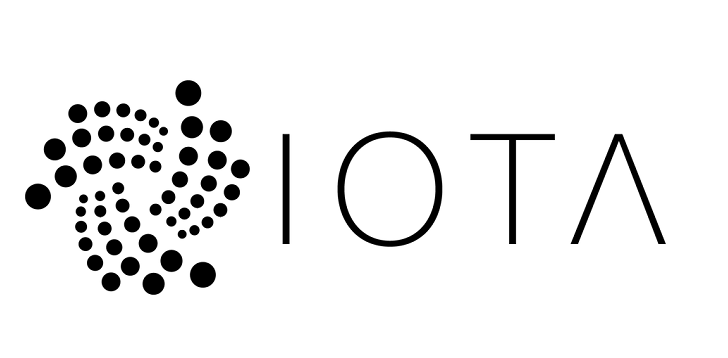
IOTA is a cryptocurrency, but not just any cryptocurrency, ofcourse.
IOTA aims to establish itself as the backbone of which the Internet of Things could not do without.
It focuses primarily on machine-to-machine transactions, and sets itself apart from all other cryptocurrencies by utilizing what are known as directed acyclic graphs, rather than a blockchain.
This central innovation is what has allowed IOTA to achieve 3 major milestones never before seen in the cryptocurrency space: zero-cost transactions, offline transactions, and infinite scalability.
Let us go over these factors, as they will allow us to truly consider if IOTA will be the technology to bring the IoT to life.
Transaction Costs:
IOTA is the first cryptocurrency created without the use of a blockchain. It’s main innovation, the Tangle, uses directed acyclic graphs to perform peer-to-peer data-sharing and micro-transactions with absolutely no fees.
How is this done, you might ask?
You see, in a traditional blockchain, proof of work is completed when miners verify transactions bundled up within a block. In contrast, the Tangle utilizes a different protocol: one where each transaction forms a brand new block and essentially verifies itself. In order for one to successfully complete a transaction on the Tangle, one must first verify two other pending transactions, allowing for an extremely simple version of proof of work to take place.
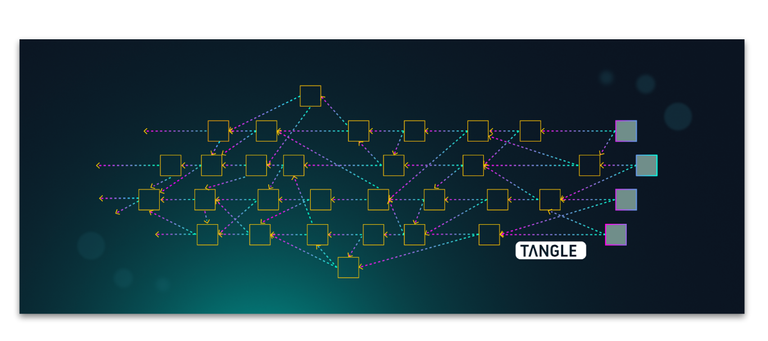
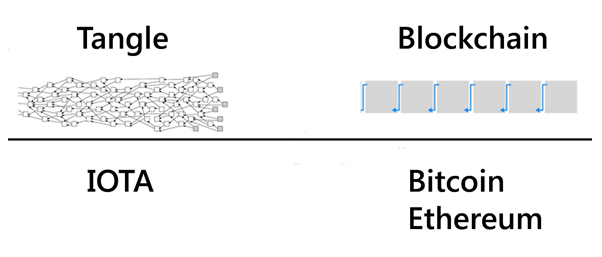
Scalability:
In a traditional blockchain, scalability becomes hindered as more and more people perform transactions within that specific blockchain. However, on the Tangle, since every transactions verifies two other pending transactions, scalability rises with adoption. In other words, as more and more users perform transactions on the network, settlement times become much quicker: allowing for a true global “blockchain” to take place.
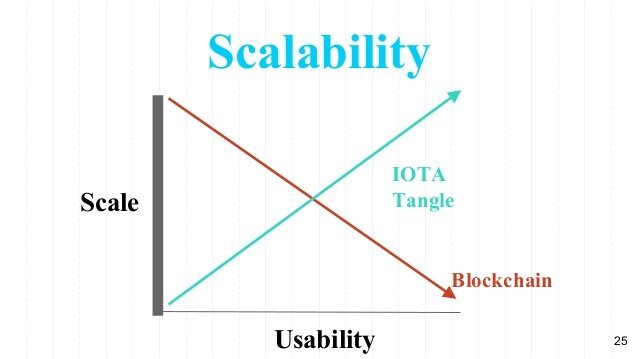
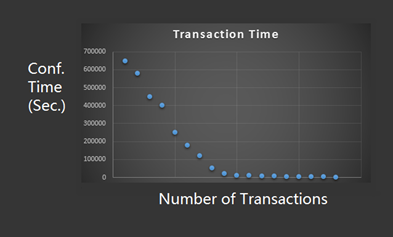
Offline Transactions:
Through the use of sub-tangles that become interwoven with the main tangle at a later time, IOTA users are given the opportunity to perform offline transactions: a feature that, to this date, has remained unheard of. While many argue its usability, the offline transaction feature of IOTA’s tangle offers high promises for future application within many industries.
Carsten Stöcker, core IOTA developer, told Cointelegraph, “IOTA is the first permissionless distributed ledger that achieves scalability, making machine-to-machine payments for the IoT possible.”
Conclusion
Overall, it is clear to see that the IOTA project is an ambitious one indeed. Although its use-case may seem flakey to some, this is expected as many don’t truly understand how the Internet of Things will integrate itself into daily human life. IOTA is a cryptocurrency that, I believe, could completely revolutionize the way distributed ledger networks are implemented into mainstream adoption. Although its timeline seems far into the future, we must remember that the number of connected devices is exponentially growing every year, and as this progresses, a central and powerful network backbone becomes absolutely necessary.
I hope you enjoyed reading this article, and that it has given you greater insight into the vision and plan of the IOTA project as a whole.
If you received any value from this post, feel free to share it so others can read it as well!
Follow @TheCoinEconomy on all social media platforms in order to receive the latest insight on the cryptocurrency market and advancement of blockchain tech. (TradingView, Twitter, Instagram, Facebook, StockTwits.)
(Disclaimer: While this article does not serve to incentivize the purchase of IOYA of tokens, I will say that I do own some myself, and I have added them to my long-term portfolio. I have done this because I believe that IOTA will have a bright future, and I certainly want to be a part of it.)
pocketsend:100@thecoineconomy, great article and IOTA has a great future ahead of it.
Successful Send of 100
Sending Account: wekkel
Receiving Account: thecoineconomy
New sending account balance: 1993546
New receiving account balance: 99
Fee: 1
Steem trxid: 46212b628f8908326380dce7bd753a82c9c9d54a
Thanks for using POCKET! I am running this confirmer code.
Successful Send of 100
Sending Account: wekkel
Receiving Account: thecoineconomy
New sending account balance: 1993546
New receiving account balance: 99
Fee: 1
Steem trxid: 46212b628f8908326380dce7bd753a82c9c9d54a
Thanks for using POCKET! MasterPocket is running this confirmer code.